FHA Loan or Conventional Loan – What’s Better?
FHA loans and conventional loans are the most common options you’ll hear when you look for home financing in Colorado. Is one better than the other?
It depends on your circumstances. Borrowers with low credit scores, but decent debt ratios qualify for FHA financing, whereas borrowers with great credit and low debt-to-income ratios qualify for conventional financing and FHA loans.
Both options have requirements, which I’ve broken down for you below.
Credit Score Requirements for FHA and Conventional Loans
The credit score requirements are the largest factor setting these loans apart. FHA loans have the most flexible guidelines. You may qualify with a credit score as low as 580 with a 3.5 percent down payment or 500 with a 10 percent down payment.
Conventional loans require at least a 620 credit score (many require a higher minimum credit score). They don’t offer a lower credit score option with a higher down payment, but conventional lenders don’t have the government insurance guarantee FHA lenders receive.
If you have great credit, consider a conventional loan, as you may pay less in mortgage insurance for this option. If you don’t have the credit to qualify for a conventional loan, though, an FHA loan is a great option.
Down Payment Requirements for FHA and Conventional Loans
As I said above, FHA borrowers can put down as little as 3.5 percent and secure a loan. If you have at least a 619 credit score, you may use gift funds for 100 percent of the down payment. If your credit score is between 580 – 619, the entire 3.5 percent down payment must come from you. If you have a 500 – 579 credit score, you need a 10 percent down payment and 3.5 percent of the funds must be yours, while 7.5 percent can be a gift.
Conventional loans require a minimum 5 percent down payment. You may use gift funds toward the down payment, but the amount you must contribute varies by lender and your qualifying factors.
Here’s an example of how they differ. If you bought a $200,000 home, you’d need the following down payment amounts:
- FHA loan with a 580 credit score - $7,000
- FHA loan with a 500 – 579 credit score - $20,000
- Conventional loan - $10,000
Owner Occupancy Requirements for FHA and Conventional Loans
FHA loans require owner occupancy. You must certify that you’ll live in the property as your primary residence year-round to secure financing. Conventional loans don’t require owner occupancy.
FHA and Conventional Loan Limits
All loans have loan limits, including FHA and conventional loans. This is one downside of the FHA loan. While they have flexible underwriting guidelines, they limit how much you may borrow. The FHA loan limits vary from $331,760 and $765,600. The exact amount varies by county as the FHA allows 115 percent of the average home price in the area.
Conventional loans have one limit - $510,400 in 2020. The limits don’t vary by county unless you live in a high-cost area.
Both FHA and conventional loans base your loan amount on your qualifying factors. The limits are the maximum amount you ‘may’ borrow, but you must prove you can afford and have the credit history to prove you can manage it.
FHA and Conventional Loan Mortgage Insurance
FHA loans have mortgage insurance on every loan. The FHA charges an upfront mortgage insurance fee and annual mortgage insurance.
Borrowers pay 1.75 percent of the loan amount at the closing. This is the upfront MIP. The FHA also charges 0.85 percent of the loan amount annually. If you borrow $200,000, you pay $1,700 per year or $142 a month for the first year. The annual MIP drops each year as you pay your principal balance down.
You cannot cancel FHA mortgage insurance. As long as you have an outstanding principal balance, you pay MIP on the balance.
Conventional loans only charge Private Mortgage Insurance if you make less than a 20 percent down payment. The PMI costs vary based on your credit score and loan-to-value ratio. You may cancel PMI once you owe less than 80 percent of the home’s value.
Refinancing FHA and Conventional Loans
Both FHA and conventional loans offer rate/term and cash-out refinance options. FHA loans have similar flexible underwriting guidelines for its refinance programs as it does the purchase programs.
FHA borrowers may be eligible for the FHA streamline refinance, which is a fast refinance process that doesn’t verify your income, credit, or home value. If you can prove you’d have a net tangible benefit by refinancing and you made your last 12 FHA loan payments on time, you may qualify.
*A net tangible benefit means refinancing may lower your payment or provide you with a better term, either shorter or less risk (ARM to fixed-rate loan).
Conventional loans have the same refinancing guidelines as they do for purchase loans. They don’t have a streamline refinance option, though; you’ll always verify your income, credit, and home value.
Both FHA and conventional loans have an 80 percent maximum loan-to-value requirement for cash-out refinances. This means you must leave at least 20 percent of your equity untouched if you tap into your home’s equity.
Are you trying to choose between an FHA and conventional loan? Let me help you see the differences and determine which loan suits your qualifying factors and financial needs the best.

